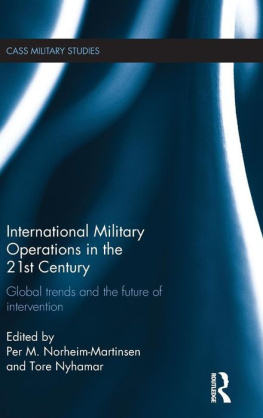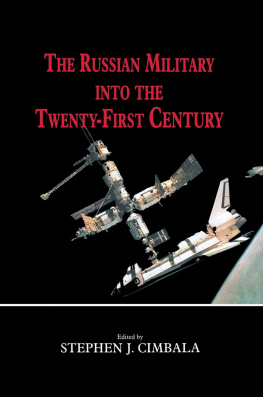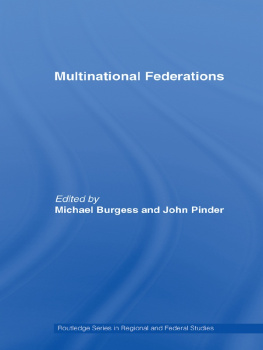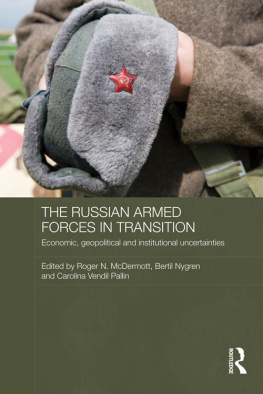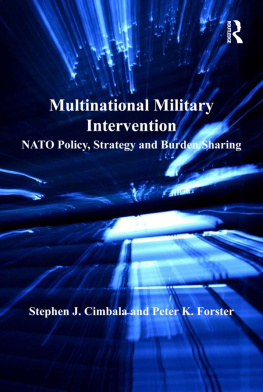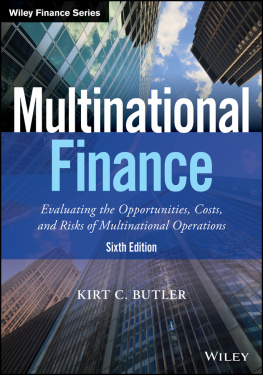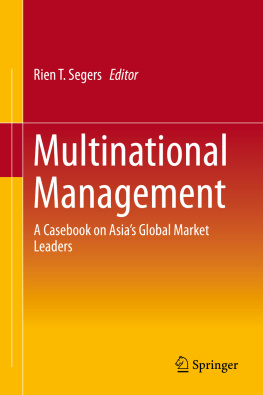ADELPHI
Paper 294
Multinational Military Forces:
Problems and Prospects
First published April 1995 by Oxford University Press for
The International Institute for Strategic Studies
23 Tavistock Street, London WC2E 7NQ
This reprint published by Routledge
2 Part Square, Milton Park, Abingdon, Oxon, OX14 4RN
For the International Institute for Strategic Studies
Arundel House, 13-15 Arundel Street, Temple Place, London, WC3R 3DR
www.iiss.org
Simultaneously published in the USA and Canada
By Routledge
711 Third Avenue, New York, NY 10017
Routledge is an imprint of the Taylor & Francis Group, an informa business
The International Institute for Strategic Studies 1995
Director: Dr John Chipman
All rights reserved. No part of this publication may be reproduced, stored in a retrieval system or transmitted in any form or by any means, electronic, mechanical or photo-copying, recording or otherwise, without the prior permission of the International Institute for Strategic Studies. Within the UK, exceptions are allowed in respect of any fair dealing for the purpose of research or private study, or criticism or review, as permitted under the Copyright, Designs and Patents Act, 1988, or in the case of reprographic reproduction in accordance with the terms of the licences issued by the Copyright Licensing Agency. Enquiries concerning reproduction outside these terms and in other countries should be sent to the publisher.
This book is sold subject to the condition that it shall not, by way of trade or otherwise, be lent, re-sold, hired out or otherwise circulated without the publisher's prior consent in any form of binding or cover other than that in which it is published and without a similar condition including this condition being imposed on the subsequent purchaser.
Bristish Library Cataloguing in Publication Data
Data available
Library of Congress Cataloging in Publication Data
ISBN 0-19-828025-4
ISBN 0567-932X
| ACE | Allied Command Europe |
| ARRC | Allied Command Europe Rapid Reaction Corps |
| CIS | Commonwealth of Independent States |
| CJTF | Combined Joint Task Force |
| CSCE | Conference on Security and Cooperation in Europe (now Organisation for Security and Cooperation in Eurone OSCE) |
| ECOMOG | ECOWAS (Economic Community of West African States) peacekeeping force in Liberia |
| EU | European Union |
| NATO | North Atlantic Treaty Organisation |
| PFP | Partnership for Peace |
| ROE | rules of engagement |
| SACEUR | Supreme Allied Commnader Europe |
| SACLANT | Supreme Allied Commander Atlantic |
| SHAPE | Supreme Headquarters Allied Powers Europe |
| UN | United Nations |
| UNHQ | United Nations headquarters |
| WEU | Western European Union |
Since the breaching of the Berlin Wall in 1989 and the subsequent end of the Cold War, there has been a marked increase in attention paid to multinational military forces. Developments have been both organisational, such as restructuring the North Atlantic Treaty Organisation (NATO); and operational, for example, United Nations (UN) involvement in missions that threaten to escalate beyond peacekeeping into more military-demanding peace enforcement. The two coalesce as the UN seeks to employ the resources of regional organisations, such as NATO, for these missions.
The problems of bringing together military forces from disparate nations range from the practical to the political and cultural. As levels of multinational integration rise to meet either political or budgetary imperatives, difficulties multiply, military organisation is degraded, and military effectiveness put at risk. More UN operations have been authorised in recent years than ever before, many running concurrently. This trend towards more multidisciplinary missions with ever-wider mandates, together with an increase in the intensity of factional conflict, exacerbates the problems. Furthermore, institutional and national factors, and the involvement of the permanent members of the UN Security Council (UNSC) in peace-support operations, are subjecting multinational force operations and developments to an ever-widening political agenda.
This paper highlights the problems of multinational formations and indicates the sorts of measures required for them to become effective policy instruments. There are two broad categories of multinational force: coalition forces brought together for a specific purpose (for example, under a UN banner), and alliance forces with a permanent multinational structure in peace and war. In this analysis the latter category concentrates on the European theatre, where the most substantive multinational force developments are currently taking place. This study focuses on land forces where fewer attempts have been made to establish integrated formations, and whose problems are more complex than those of the air and maritime environments, with their many years of multinational cooperation and use of English as the international language.
covers problems specific to particular combat environments before examining current multinational force initiatives, such as the Allied Command Europe Rapid Reaction Corps (ARRC), the Multinational Division (Central), the Euro-Corps and the Combined Joint Task Force (CJTF) concept, to demonstrate the problems in different forms of integration.
The construction of multinational forces, the pace at which they develop, the political symbolism and military capability built into them, and their effectiveness are all determined by the political context. This includes the institutional framework within which the forces will operate; varied national objectives and expectations; public perceptions; and great-power politics. The political context is dynamic, as nations and alliances adapt their policies, expectations and ambitions to the post-Cold War situation. This shifting dynamic complicates the development of multinational formations and the achievement of the political consensus essential for successful multinational undertakings.
The Institutional Dimension
NATO and the United Nations
In Western Europe prior to 1989, multinational constructs never had to be tested in action. Their apparent solidarity was at least as important as their prospective military efficiency. Fissiparous tendencies within NATO, for example, were neutralised by the perception of an overwhelming threat from the East. Relatively few genuinely multinational formations existed, particularly land formations, there was little public scrutiny, and questions of force status and military requirements were deferred to senior military officials. Thus a gap existed between planning, perceptions and reality.
Multinational operations under UN auspices prior to 1989 were few (13 in 40 years), and could be characterised as traditional peacekeeping missions in which a multinational force, sometimes comprising only a small number of military observers, was interposed between two protagonists who agreed to the UN's presence. The difficulties inherent in such multinational operations were largely ignored over time, principally because the conflicts involved were of marginal strategic significance given the predominance of the East-West confrontation.


